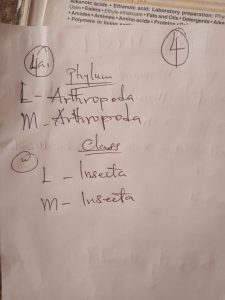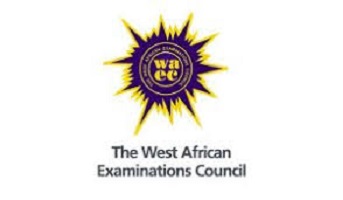Waec biology practical answers 2021
Here is the waec biology practical answers 2021 straight up, no Time for delays. Share to your friends.
Waec biology practical answers…
1ai
A- Neck region
B- chest region
C- upper abdominal region
*1aii*
A- it allows the head to nod on it (i.e it permits nodding of the head)it fits into the oceipital condylies of the skull
B- it aids the attachments of the ribs
C- Lumber vertibra provides attachment for the abdominal muscles(1ai)
A – Neck
B – Chest
C – Upper abdominal region of the body
(1aii)
A – It aids the odontoid process of the head
B – It aid the attachment of ribs
C – It bears majority of body weight
(1bi)
[img]https://i.imgur.com/WQWkJCO.jpg[/img]
(1bii)
(i) Neural canal; It allows the passage of the spinal cord
(ii) Centrum; It is a solid piece of bone found below the neural canal
(iii) Transverse process; It aids the attachment of muscle and ligaments
(iv) Neural spine; The aids the attachment of muscles
(1ci)
A – 7
B – 12
C – 6
(1cii)
(i)Sacral vertebrae
(ii) Caudale vertebrae
(4ai)
Phylum
L – Arthropoda
M – Arthropoda
(ii)
Class
L – Insecta
M – Insecta
(4biii)
– 6 legs
– 4 wings
– chitinous exoskeleton
– antenna
(2a)
PLEASE TABULATE
= D
-Two observation-
(i) Gives greenish leaves
(ii) Gives a growing seedlings
-Results-
Positive growth
= E
-Two observation-
(i) No growth observed
(ii) Wet soil
-Results-
Negative growth
= F
-Two observation-
(i) No growth observed
(ii) Dey soil
-Results-
Negative growth
= G
-Two observation-
(i) No growth observed
(ii) Extremely dry soil
-Results-
Negative growth
(2bi)
E – Excess water
F – Depletion of soil nutrient
G – Absence of water or soil moisture
(2bii)
(i) Well ventilated soil
(ii) Good and rich in nutrient soil
(2c)
[img]https://i.imgur.com/r884Qna.jpg[/img]
(4ai)
Phylum
L – Arthropoda
M – Arthropoda
(ii)
Class
L – Insecta
M – Insecta
(4bi)
(i)They have an exoskeleton or a hard, shell-like covering on the outside of its body.
(ii)Insects have three main body parts: head, thorax, and abdomen.
(iii)Insects have a pair of antennae on top of their heads.
(4bii)
(i)myriapods
(ii)arachnids
(iii)crustaceans
(4ci)
= L
(i) It serves as vector of disease causing organisms
(ii) It bits organisms
= M
(i) It serves as an agent of pollination
(ii) It serves as food to some predators
(4cii)
(i)Controlled by Mosquito Traps
(ii)Controlled by Space sprays
(iii)Controlled by Mechanical Barriers
(iv)Controlled by
Vegetation Management.
(v)Controlled by outdoor measures.
(4d)
TABULATE PLS
– H (ADULT MOSQUITO)
(i) Smaller in size
(ii) A Pair of wings
(iii) Absence of hard hind wings
(iv) Absence of maxillary palp/maxilla
(iv) Absence of spines on legs
– M(BUTTERFLY)
(i) Big in size
(ii) Two pairs of wings
(iii) Presence of hard hind wings
(iv) Presence of maxillary palp/maxilla
(v) Presence of spines on legs
(4dii)
(i) Possession of wings
(ii) Possession of antenna
(iii) They both flies
(iv) Possession of segmented body
(4e)
L – Marshes
M – Grassland
(4ai)
Phylum
L – Arthropoda
M – Arthropoda
(ii)
Class
L – Insecta
M – Insecta
(4biii)
– 6 legs
– 4 wings
– chitinous exoskeleton
– antenna



(4ai)
Phylum
L – Arthropoda
M – Arthropoda
(ii)
Class
L – Insecta
M – Insecta
(4bi)
(i)They have an exoskeleton or a hard, shell-like covering on the outside of its body.
(ii)Insects have three main body parts: head, thorax, and abdomen.
(iii)Insects have a pair of antennae on top of their heads.
(4bii)
(i)myriapods
(ii)arachnids
(iii)crustaceans
(4ci)
= L
(i) It serves as vector of disease causing organisms
(ii) It bits organisms
= M
(i) It serves as an agent of pollination
(ii) It serves as food to some predators
(4cii)
(i)Controlled by Mosquito Traps
(ii)Controlled by Space sprays
(iii)Controlled by Mechanical Barriers
(iv)Controlled by
Vegetation Management.
(v)Controlled by outdoor measures.
(4d)
TABULATE PLS
– H (ADULT MOSQUITO)
(i) Smaller in size
(ii) A Pair of wings
(iii) Absence of hard hind wings
(iv) Absence of maxillary palp/maxilla
(iv) Absence of spines on legs
– M(BUTTERFLY)
(i) Big in size
(ii) Two pairs of wings
(iii) Presence of hard hind wings
(iv) Presence of maxillary palp/maxilla
(v) Presence of spines on legs
(4dii)
(i) Possession of wings
(ii) Possession of antenna
(iii) They both flies
(iv) Possession of segmented body
(4e)
L – Marshes
M – Grassland
(4dii)
(i) Possession of wings
(ii) Possession of antenna
(iii) They both flies
(iv) Possession of segmented body
(4e)
L – Marshes
M – Grassland

